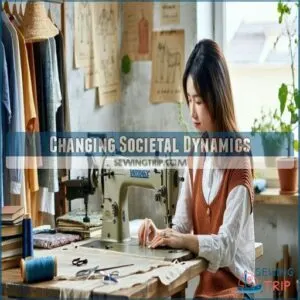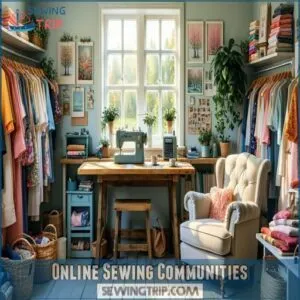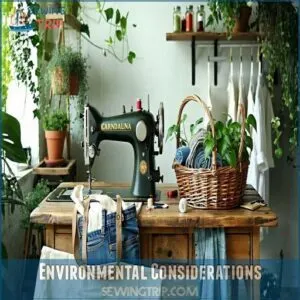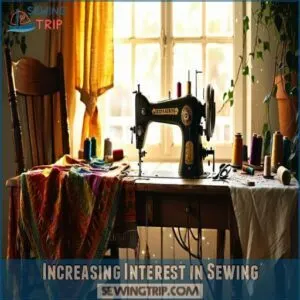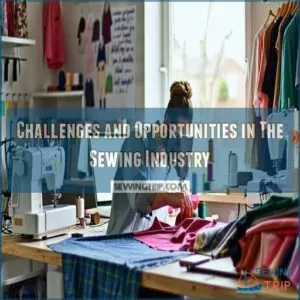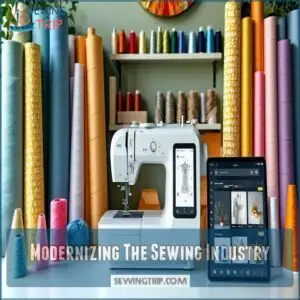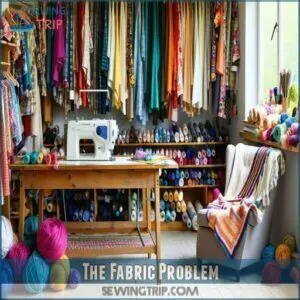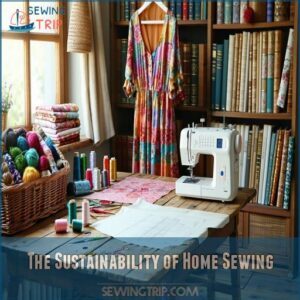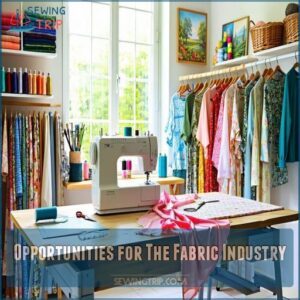This site is supported by our readers. We may earn a commission, at no cost to you, if you purchase through links.
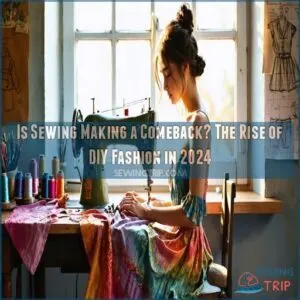
Social media’s buzzing with tutorials, while eco-conscious crafters are stitching sustainability into every seam. Today’s sewists aren’t just making clothes; they’re building tight-knit online communities, sharing tips, and challenging fast fashion norms.
From tech-savvy sewing machines to zero-waste patterns, modern makers are threading together tradition and innovation. There’s more to this craft than meets the eye—wait until you discover what’s possible with just a needle and thread.
Table Of Contents
- Key Takeaways
- The Rise of Sewing in The COVID-19 Era
- Factors Influencing Sewing’s Revival
- Increasing Interest in Sewing
- Challenges and Opportunities in The Sewing Industry
- Modernizing The Sewing Industry
- The Fabric Problem
- Sewing for More Than Just Saving Money
- The Sustainability of Home Sewing
- Opportunities for The Fabric Industry
- Frequently Asked Questions (FAQs)
- Conclusion
Key Takeaways
- You’re part of a massive revival – over 7 million people have taken up sewing since 2020, contributing to a $5.8 billion market that’s reshaping how we think about making clothes.
- You’ll find a thriving online community where sewists share tips, swap patterns, and challenge fast fashion norms through social media platforms, blogs, and virtual sewing circles.
- You’re not just saving money – modern sewing combines sustainability with self-expression, as you can create unique pieces while reducing textile waste and supporting eco-friendly practices.
- You don’t need a local fabric store anymore – though traditional shops are closing, you have access to digital patterns, online tutorials, and tech-savvy sewing machines that make learning and creating easier than ever.
The Rise of Sewing in The COVID-19 Era
The pandemic sewing boom wasn’t just a flash in the pan – it sparked a genuine revival that’s still going strong in 2024. You might’ve noticed how the COVID-19 pandemic transformed kitchen tables into makeshift sewing stations as people discovered their inner craftsperson during lockdown.
What started with DIY mask making quickly evolved into a full-blown home sewing resurgence, with millions finding comfort in creating their own clothes and accessories.
Sewing’s comeback has proven to be more than just a way to pass time – it’s become a form of lockdown creativity and stress relief. Whether you’re mending clothes, crafting home décor, or designing your own wardrobe, this hands-on hobby offers a restorative break from screen time.
The sewing revival has united people across generations, proving that sometimes the best way to handle uncertainty is to create something beautiful with your own hands.
Factors Influencing Sewing’s Revival
Thanks to social media, sustainability concerns, and a growing desire to create unique, personalized fashion, your grandma’s favorite hobby isn’t just making a comeback – it’s becoming the coolest trend of 2024.
Whether you’re scrolling through TikTok sewing tutorials or joining online crafting communities, you’re part of a movement that’s transforming this traditional craft into a modern expression of creativity and environmental consciousness.
Changing Societal Dynamics
While lockdowns sparked initial interest in sewing, today’s DIY culture runs deeper. You’re part of a generational shift where mindful consumption meets self-expression resurgence.
Modern sewists aren’t just making clothes—they’re challenging fast fashion norms and embracing slow fashion movement values.
Whether you’re seeking creative control or sustainable alternatives, the sewing comeback reflects broader changes in how we think about clothing and creativity.
Online Sewing Communities
Social media has sparked a sewing comeback through bustling virtual sewing circles and pattern-sharing platforms. You’ll find countless sewists swapping tips on Instagram, sharing wins on Pinterest, and troubleshooting techniques in Facebook groups.
The presence of online sewing groups has further facilitated this growth. Digital fabric swaps and online class discussions have created tight-knit communities where beginners and experts connect.
Sewing blogs and forums offer round-the-clock support, making it easier than ever to join this creative revolution.
Environmental Considerations
Beyond just stitching up cute outfits, environmental considerations are driving more people to pick up a needle and thread.
You’ll find eco-conscious sewists choosing recycled textiles and sustainable materials, turning old jeans into trendy tote bags.
Green sewing practices, from using eco-friendly fabrics to embracing zero-waste patterns, are reshaping the craft’s environmental impact.
It’s not just about looking good—it’s about feeling good about your fashion choices.
Increasing Interest in Sewing
You’ll find more sewing machines humming in homes across America than ever before, with over 7 million hobbyists picking up needles and threads to create their own fashion statements.
Whether you’re inspired by your favorite TV shows or YouTube tutorials, you’re part of a growing movement that’s bringing personal style back to your wardrobe, one stitch at a time.
Sales Statistics and Patterns
While market trends show a remarkable 60% surge in pattern sales and a 30% jump in sewing machine purchases, the modern sewing comeback reflects deeper shifts in consumer behavior.
Industry forecasts predict sustained growth, with current sewing demographics spanning all age groups.
Here’s what’s driving the sewing trend:
- Over 7 million active hobbyists nationwide, creating a $5.8 billion market
- Direct-to-consumer sales up 25% in specialty stores
- Holiday season peaks showing 30% higher sales
- Sustainable and eco-friendly products commanding 20% premium prices
Influence of TV Shows and YouTube Tutorials
Looking for your next sewing project? You’re not alone.
TV shows like Project Runway and The Great British Sewing Bee have sparked a creative revolution, while YouTube’s explosion of sewing tutorials has transformed how we learn.
Digital patterns and online classes have made it easier than ever to pick up this trending hobby. Many crafters find sewing tutorials essential for improving their skills.
From beginner basics to advanced techniques, video lessons are turning curious crafters into confident creators. The sewing comeback is real, and it’s streaming straight to your screen.
Vintage Patterns and Therapeutic Appeal
Beyond video tutorials, there’s something magical about vintage patterns that’s drawing modern sewists in. You’ll find these retro treasures offer both creative outlet and mental escape. Here’s what makes vintage pattern sourcing so appealing:
- Each stitch becomes a mindful meditation, helping you slow down and destress.
- Slow fashion therapy through making becomes your personal healing journey.
- Working with classic designs connects you to sewing’s rich history.
- Vintage patterns teach timeless construction techniques.
- The satisfaction of creating something unique brings joy.
Challenges and Opportunities in The Sewing Industry
The sewing industry today presents both obstacles and exciting possibilities. Traditional fabric stores are closing, while online communities and digital platforms are opening new avenues.
While the touch-and-feel experience of local shops might be missed, access to a world of virtual pattern libraries, online tutorials, and social media communities is changing how we create and share handmade fashion.
Closure of Fabric Stores
Fabric stores across the nation are closing their doors at an alarming rate, leaving sewing enthusiasts scrambling for alternatives. If you’re feeling the pinch of vanishing local shops, you’re not alone.
While online retailers offer convenience and variety, the impact on communities runs deep.
Your best bet? Mix it up by combining online shopping with creative sourcing – think thrift stores, swap meets, and local sewing communities. Supporting remaining brick-and-mortar shops helps guarantee they’ll stick around for hands-on fabric browsing.
Appeal to Millennials and Younger Generations
Millennials and Gen Z are embracing DIY fashion and upcycling to create unique, personalized pieces that reflect their values, even as physical stores decline. This contrasts with fast fashion’s disposable culture, emphasizing mindful creation and skill development. Many are exploring sewing projects to express their individuality.
This creative spirit extends beyond personal expression. Sharing sustainable sewing successes online fosters community connection. This transforms a traditional craft into a modern statement against mass production.
The motivation goes deeper than saving money. It’s about reclaiming creativity and control over their style.
Role of Social Media and Online Platforms
Today’s sewing scene is thriving on every social platform. From step-by-step Instagram Reels to in-depth YouTube tutorials, online communities have transformed how we learn and share our craft.
Virtual classes connect you with expert sewists worldwide. Sewing blogs offer detailed guides for projects of all levels.
Online fabric shops bring an endless selection right to your screen, making it easier than ever to start creating.
Modernizing The Sewing Industry
Despite recent fabric store closures, the sewing industry hasn’t slowed down – it’s just changing lanes. Tech-integrated sewing machines now let you download designs straight to your device, making complex projects easier than ever. Digital pattern downloads have replaced bulky paper patterns, giving you instant access to thousands of designs from your tablet or phone.
The rise of sewing technology has also led to innovative tools and platforms that support home sewists. Online sewing courses are booming, with seasoned sewists sharing their expertise through video tutorials and interactive workshops. Collaborative sewing platforms connect beginners with experts, creating virtual communities where skills and inspiration flow freely.
The fashion industry is taking notice too. Sustainable fabric sourcing has become a priority, with many manufacturers offering eco-friendly options for home sewists. Innovation in sewing technology continues to push boundaries – from automated thread tension to built-in pattern libraries, making this age-old craft more accessible and enjoyable than ever.
The Fabric Problem
While technology modernizes sewing practices, fabric sourcing remains a persistent challenge. Local fabric stores are becoming scarce, making material access trickier than ever.
But here’s the silver lining: creative solutions are popping up everywhere. From Instagram fabric-swap communities to small-batch sustainable fabrics on Etsy, you’re not limited to traditional retailers anymore.
Understanding the fabric cost list is essential to making informed decisions about your sewing projects. The fabric cost might seem steep at first, but think about it – you’re investing in quality materials that outlast fast fashion alternatives.
Smart sewists are tackling textile waste by repurposing old clothes or connecting with ecoconscious designers who create custom prints on organic cotton.
Can’t find what you need locally? Join online communities where fellow makers share their favorite sources. Some even organize group buys to make specialty fabrics more affordable. Between virtual marketplaces and community connections, you’ll discover unique materials that match your style and values.
Sewing for More Than Just Saving Money
The joy of sewing stretches far beyond saving money on clothes – it’s become your gateway to creative expression and personal growth. Your handmade pieces tell stories that mass-produced items never could, whether it’s that perfectly fitted dress or a quilted wall hanging that brightens your space. Your personal style shines through in every stitch, making each project a unique reflection of who you are. It’s more than a hobby – it’s a form of self-expression that feeds your soul.
When you’re behind the machine, you’re not just stitching fabric; you’re developing skills that boost confidence and reduce stress. As you master new techniques, from pattern matching to buttonholes, you’re building a skill set that brings both pride and practical value. The act of sewing therapy can have a profound impact on mental wellbeing, allowing sewers to unwind and express themselves.
You’ll find yourself part of a vibrant community that shares tips, celebrates wins, and supports each other’s creative journeys.
The Sustainability of Home Sewing
Every stitch you sew at home contributes to slow fashion and a healthier planet. By embracing mindful creation, you’re not just making clothes—you’re taking a stand against fast fashion’s environmental impact.
Home sewing lets you control your fabric’s journey from start to finish, ensuring ethical sourcing and extending fabric lifespan through careful construction. To learn more about sustainable sewing, consider exploring techniques that reduce waste and support eco-friendly fashion choices.
- Transform old jeans into trendy tote bags by repurposing scraps
- Give vintage bedsheets new life as summer dresses
- Fix loose buttons and torn seams instead of tossing clothes
- Choose organic, locally-sourced materials for ecofriendly fashion
- Create zero-waste patterns that maximize fabric use
When you sew at home, you’re crafting more than just clothes—you’re stitching together a sustainable future, one project at a time. That’s the real beauty of this hands-on approach to sustainability.
Opportunities for The Fabric Industry
Today’s fabric industry stands at a crossroads of innovation and opportunity. Exciting developments in digital printing let designers create unique patterns on sustainable textiles, opening doors for collaborative partnerships.
Niche markets are booming as sewists demand specialized materials for their projects. Smart manufacturers are tapping into this trend by offering eco-friendly options and partnering with independent designers.
The fashion industry’s shift toward sustainability has created new opportunities in fabric sourcing, with many companies now focusing on organic and recycled materials.
Local textile producers are finding success by hosting workshops and building online communities. From customizable prints to subscription-based fabric clubs, there’s no shortage of ways to innovate.
If you’re in the textile industry, now’s the time to embrace technology, sustainability, and community-building to stay ahead of the curve.
Frequently Asked Questions (FAQs)
How has sewing changed over the years?
From stone-age bone needles to today’s computerized machines, sewing has evolved dramatically.
It’s transformed from a basic survival skill into a tech-savvy craft that’s both practical and creative.
What is historical clothing’s comeback?
The surging popularity of historical clothing lets you explore period-accurate fashion through careful craftsmanship.
Enthusiasts recreating everything from Victorian gowns to Renaissance outfits celebrate the artistry and techniques of bygone eras.
Is wool making a comeback?
Wool surging in popularity is linked to a renewed focus on sustainability and quality.
Eco-conscious crafters value this versatile, natural fiber for its durability and warmth, demonstrating that wool is no longer just a traditional material.
Is sewing becoming popular again?
Sewing’s popularity is surging, with over 7 million hobbyists nationwide.
A thriving community embraces this creative outlet, especially since the pandemic sparked interest in DIY projects and sustainable fashion alternatives.
Why are more people sewing?
People are embracing sewing to express creativity, save money, and escape screen time.
It’s therapeutic, lets you customize clothes, and feeds that DIY spirit.
Plus, online tutorials make learning easier than ever.
Can you make a living from sewing?
Like threading a needle with golden opportunities, you can turn your sewing skills into income.
Through custom work, teaching classes, selling patterns online, or starting an alterations business, many sewists earn substantial incomes.
Is there an alternative to sewing?
You’ve got several creative alternatives: knitting brings cozy vibes, crocheting offers versatility, and needle felting lets you sculpt with wool.
These crafts deliver similar satisfaction to sewing while requiring different tools and techniques.
What age group is driving the sewing resurgence?
Millennials and Gen Z are transforming fiber arts after COVID-19, with needlework and sewing industry revenue hitting 8 million in They’re embracing it for sustainability, mental health, and creative expression.
How much does it cost to start sewing?
Getting started with sewing costs around $100- A basic machine runs $150, while fabric, needles, thread, and scissors add another $50- Look for starter kits that bundle essential supplies together.
Which sewing skills are most valuable today?
Mastering pattern reading, basic alterations, and machine maintenance offers significant value.
Essential hand-sewing techniques, garment construction, and fabric selection skills are also highly valued in today’s DIY culture.
Conclusion
Sewing’s making a comeback in ways we never expected, with over 7 million new sewists joining the craft since 2020.
Whether you’re drawn to sustainable fashion, craving a creative outlet, or just want to customize your wardrobe, there’s never been a better time to pick up a needle and thread.
As online communities grow and innovative technology meets traditional craft, sewing isn’t just surviving—it’s thriving. You’re not just making clothes; you’re joining a revolution in modern making.
- https://www.youtube.com/
- https://sewingtrip.com/is-sewing-making-a-comeback/
- https://www.ndtv.com/shopping/stitching-creativity-why-sewing-machines-are-making-a-comeback-7069650
- https://sewyoursoul.com/is-sewing-becoming-more-popular/
- https://www.colleenglea.com/2023/03/24/is-home-sewing-making-a-comeback/

